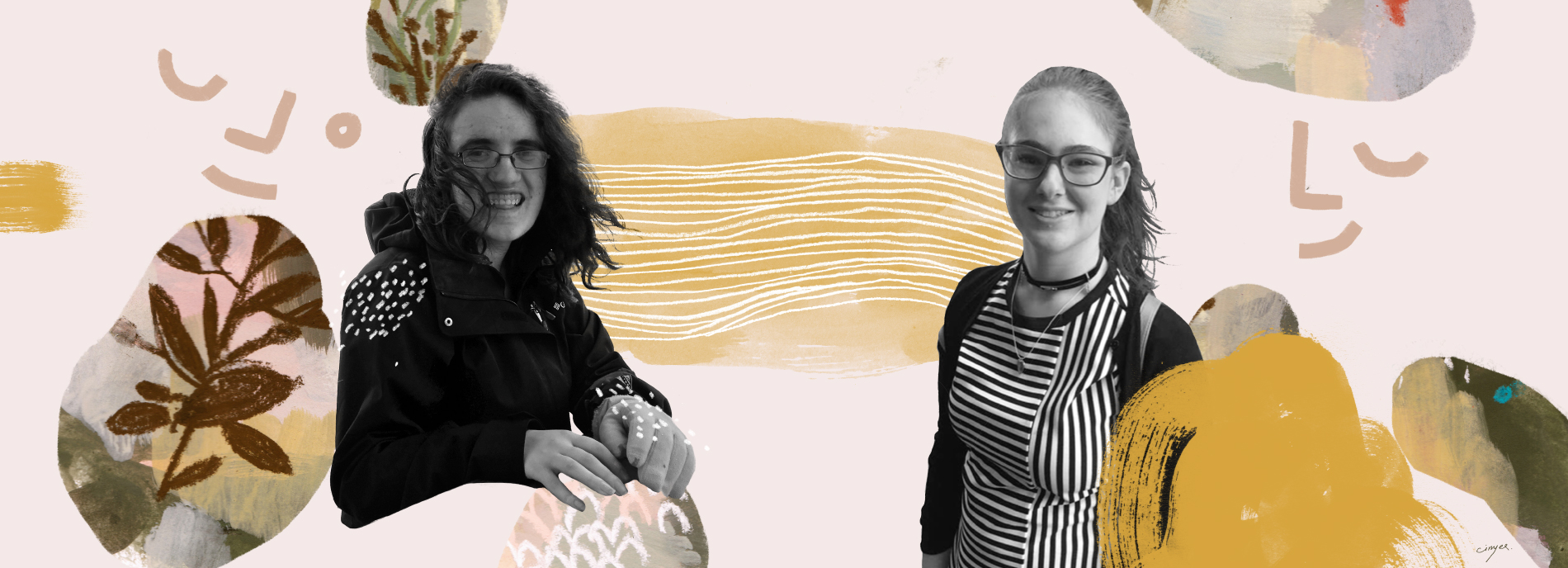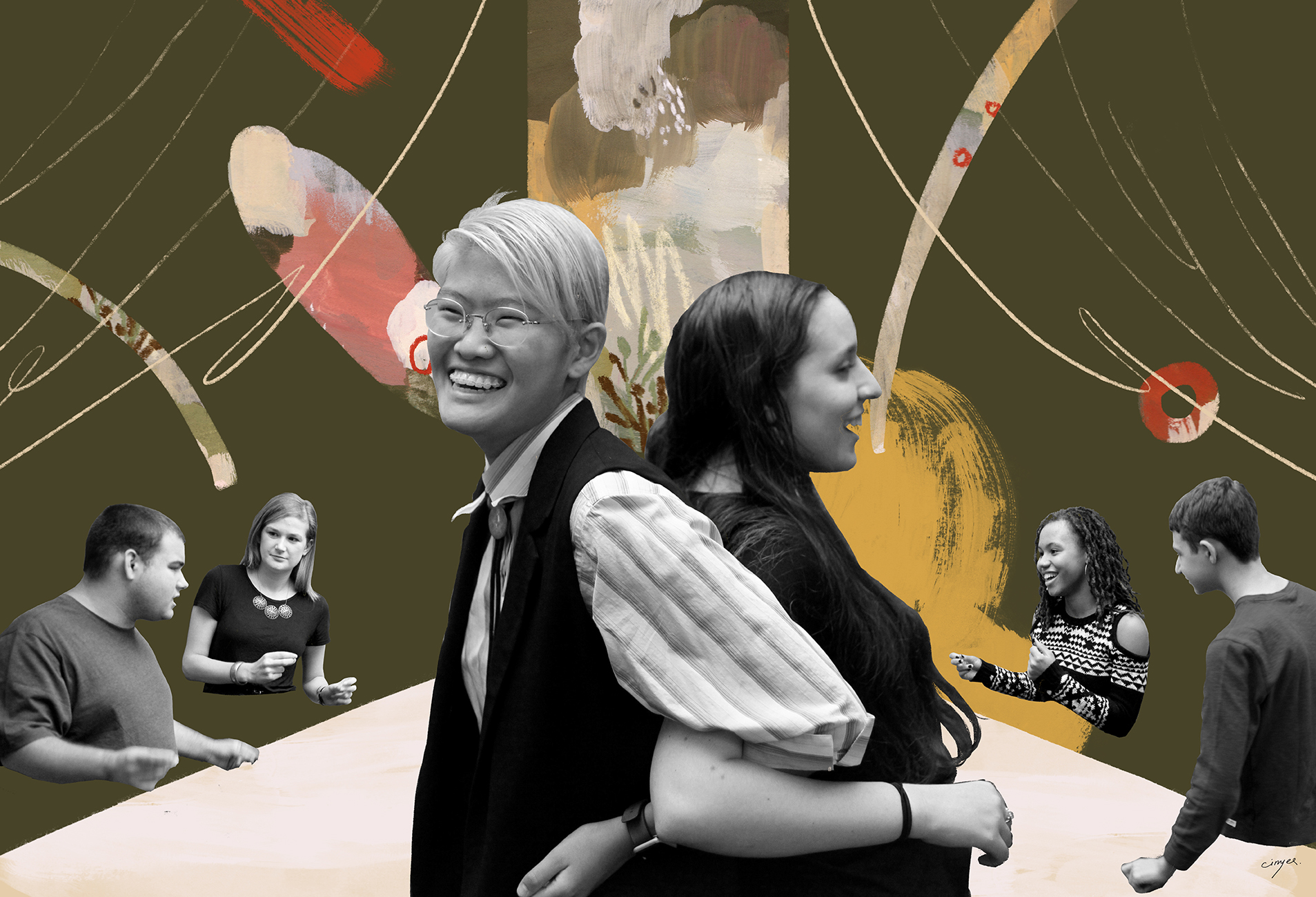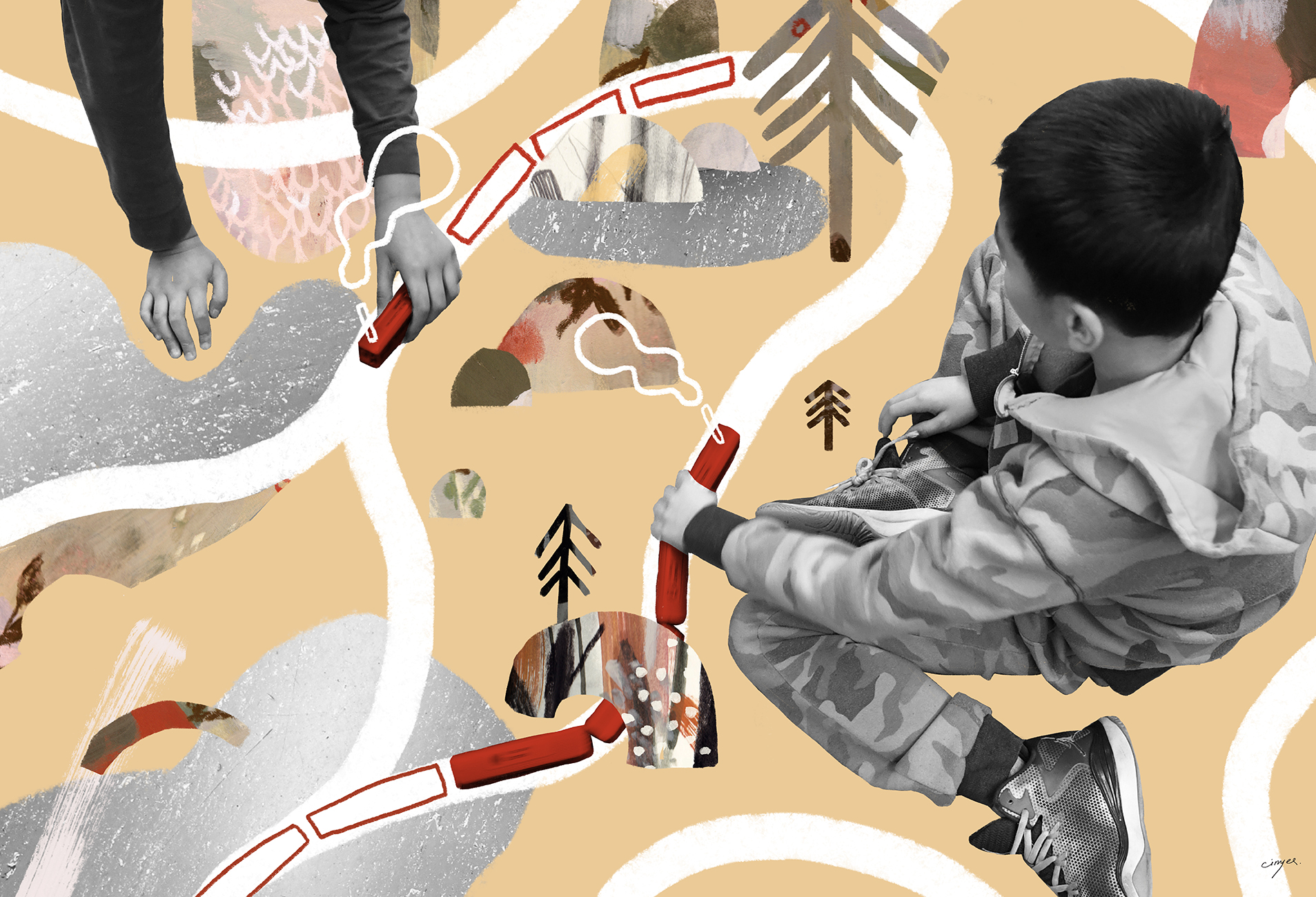
How people with autism forge friendships
Most autistic people want to and can make friends, though their relationships often have a distinctive air.
I
t is lunchtime on a Sunday in January. At a long table inside a delicatessen in midtown Manhattan, a group of young people sit together over sandwiches and salads. Most of them have their phones out. One boy wears headphones around his neck. But there is less conversation than you might expect from a typical group of friends: One of the boys seems to talk only to himself, and a girl looks anxious and occasionally flaps her hands.The young people in this group are all on the spectrum. They met through a program organized by the nonprofit Actionplay, in which young people with autism or other disabilities work together to write and stage a musical. Each Sunday, the members refine characters and the script, block scenes and compose songs — and then some of them head across the street to have lunch together. “You meet other people just like you,” says Lexi Spindel, 15.
The members share a group text in which they call themselves the Wrecking Crew. A few months ago, six of the girls went to see the movie “Frozen II” together. And Lexi and Actionplay veteran Adelaide DeSole, 21, spent a long afternoon at the Spindels’ apartment over the holiday season. The two young women played games and watched “SpongeBob SquarePants” and “Kung Fu Panda” on television. “That was the first time my daughter had a friend over,” says Lexi’s father, Jay Spindel. “That never happened before Actionplay.”
From the very first recorded cases of autism, scientists have recognized that a lack of social interaction is a central part of the condition. In his 1943 paper, Leo Kanner described one autistic girl who moved among other children “like a strange being, as one moves between the pieces of furniture.” He interpreted the behavior of autistic children as being governed by “the powerful desire for aloneness and sameness.” For decades after, scientists and clinicians supposed that people with autism do not have friends and are not interested in forging friendships. “Until recently, there was an assumption that we would have found that the number [of friends] was zero,” says Matthew Lerner, a psychologist at Stony Brook University in New York.
A new line of research is forcing a rethink of those long-held beliefs. Autistic people overwhelmingly report that they want friends. And they have shown that they can and do form friendships with both neurotypical and autistic peers, even if their interactions sometimes look different from those among neurotypical people. This reframed view of friendship aims to acknowledge and encourage a better understanding of the social lives of autistic people. It recognizes the challenges autistic people face in creating close relationships, including difficulties in processing social information and dealing with conflict. “Nothing is impossible in terms of friendships for people with autism,” Lerner says, “but it does perhaps take a different route.”
Social connection is a powerful predictor of long-term physical and mental health. Having meaningful friendships — or lacking them — has an impact on our cardiovascular and immune systems, stress responses, sleep and cognitive health. People with strong social connections survive longer, on average, than those with poor connections, according to a meta-analysis of more than 300,000 people. Loneliness, defined as a mismatch between desired and actual levels of social connection, is as great a risk factor for mortality as smoking, the analysis suggests. Autistic people may not look lonely, because they often separate themselves from others — but they can feel lonely.
In fact, autistic children tend to be lonelier than their neurotypical peers, according to a study published in 2000. And this loneliness may contribute significantly to the high incidence of depression and anxiety among autistic adults. Having more and better friendships may ease the loneliness, but there is a caveat: The friendships might be distinct from those among neurotypical people.
“The benefits probably come from autistic people finding and being supported to find the relationships that work for them,” says psychologist Felicity Sedgewick of the University of Bristol in the United Kingdom. “I don’t think putting a neurotypical standard of friendship as the standard that autistic people should be made to achieve would do anything positive at all and would probably be very negative.”
Reading the signs:
R
esearch has shown that the idea of autistic people as friendless is a myth. For example, in a 2016 meta-analysis of 18 studies including 1,768 autistic children aged 8 to 12 years, Lerner and his colleagues showed that the majority of the children reported having a friend. “Most kids with autism think about a friend, or they have close acquaintances. I don’t think they’re friendless,” says Connie Kasari, a psychologist at the University of California, Los Angeles, who has studied autistic children in mainstream schools for years. Often, however, the quality of autistic children’s friendships is poor in terms of companionship and support. Their social networks are also often small, studies suggest.One significant barrier to these friendships is neurotypicals’ conviction that autistic people are not interested in connecting with them. Appearing uninterested, however, is not always the same as being uninterested. An autistic child who looks uninterested in the games underway on a playground may in fact be overwhelmed by the noise and chaos. And an autistic adult who avoids eye contact may simply be trying to avoid overstimulation or to focus more intently on the conversation. And rhythmic, repetitive movements (hand-flapping, body-rocking and so on) are a way for some autistic people to manage their anxiety and uncertainty, not a sign of their low social interest.
“This issue about social motivation I found to be particularly pernicious, because if somebody has the assumption that another person is not interested in interacting with them, I think that’s going to affect how those two individuals interact,” says Vikram Jaswal, a psychologist at the University of Virginia in Charlottesville. “It may become a self-fulfilling prophecy.”

Photographs courtesy of Nick Morgulis / Actionplay
On the playground, for instance, autistic children tend to operate on the periphery. And for many, it is a dismal experience. “They weren’t rejected; they were ignored,” Kasari says. Autistic children also might not be able to find the children they know in the crowd. In a randomized controlled trial, Kasari and her colleagues trained three neurotypical children to promote positive social skills among the other children, whether autistic or typical. “These three little kids would go out on the playground,” Kasari says. “They were supposed to be little ambassadors during recess and help kids engage if they weren’t engaged.” That simple step led to better social networks for the children with autism. Encouraging playground staff to facilitate interactions by suggesting activities also helped. Kasari plans to investigate what combination of approaches works best for individual children: It might, for example, include gentle pushes from peers and adults, together with social-skills training.
Getting the children more engaged on the playground is a good starting point. “That’s the beginning of friendship. It’s saying, ‘We have to get you engaged and exposed to kids having fun for you to even develop a friendship,’” Kasari says. But forging a lasting friendship takes an extra ingredient: the sharing of emotional experiences. A longstanding model of friendship holds that typical children make friends by first engaging in activities together, such as playing basketball or sharing monkey bars. Deepening that friendship requires them to share emotions, either by talking about their feelings or by sharing a positive emotional experience.
Lerner and his colleagues have proposed that there are aspects of autism, including difficulty processing social information efficiently, that get in the way of this deeper phase of friendship. As a result, a child with autism may appear to find shared activities less pleasurable than a neurotypical child does. That perception then gets in the way of building a deeper connection. “It’s those subtle moments of coordination that allow for effective sharing, and if you’re out of sync, that might be the show-stopper for many folks,” he says.
Opportunities for synchrony — or at least understanding — may emerge more readily between two autistic people than between an autistic person and a neurotypical one. One of the first papers on friendships among autistic people appeared just last year. As a graduate student, Brett Heasman worked at a drop-in center for autistic adults and was struck by the extent of social interaction among the adults playing video games. He and his doctoral supervisor at the London School of Economics in the U.K. video-recorded pairs of autistic friends playing together and coded their conversational turn-taking.
They found that the conversations had far more of what Heasman calls peaks and troughs — shifts from connection to disconnection and back again — than in a conversation between two typical people. Periods of disconnection included long stretches of one person dominating the conversation or fragmented commentary unrelated to anything that had just been said. Tight conversational turn-taking and politeness would occur when a shift in the game required cooperation or a new person entered the room. Shared experiences such as having watched an amusing YouTube video could lead to engaged discussion and laughter. “There’s a lot of swinging and missing,” says Heasman, now a research associate at University College London, “but when they do connect, it goes out of the park.”
Best friends:
E
ven when autistic people reach the deeper levels of friendship, difficulties may await. Noah Britton is a psychologist and teacher who makes up one-fourth of the comedy troupe Asperger’s Are Us. Like many other people with autism, Britton is uncomfortable opening up to other people. “You spend your whole life showing people various parts of yourself, [and] they get disappointed or confused or make fun of you,” he says. “That can be really hard.”Most of Britton’s friends also have autism. “I have found for myself and for a lot of the other guys diagnosed with Asperger’s that I know, that we befriend other people with Asperger’s,” Britton says. “This is the group with whom we are most connected and similar, and so we are drawn together.”
Britton’s closest friends are the three other members of the troupe. When the group works and tours together, they have an easy camaraderie. What might look like obsessive or repetitive behavior to some — listening to the same song for hours, for example — provides moments of great unity for them, with the added bonus that they do not feel judged or shamed for their interest. “We were writing a new show, and while we were writing I wanted to listen to the same song over and over for the whole time,” Britton says. “We just listened to ‘Garden of Your Mind’ by Mr. Rogers for hours. And we were all equally excited about this.”
Even so, there are periods of upset when the members do not speak to one another for months, except about business. “We get very upset by stuff that doesn’t make sense to other people,” he says. “Sometimes we want to push people away.”
Conflict is also an area of difficulty for autistic girls and women, who cannot always easily manage or recover from it. Like most adolescents, 15-year-old Massina Commesso worries a lot about friendship and feeling included. For much of her childhood, Massina had a neurotypical best friend with whom she played games or painted her nails. But as they entered high school, the other friend pulled away, apparently out of embarrassment over some of Massina’s behavior. “She told me she didn’t want to invite me to her birthday party,” Massina says. (The other girl’s mother reportedly told Massina’s mother that her daughter “has to think about her reputation.”) Massina, who also has depression, was crushed and struggled to get past the rejection. “What am I living for?” she asked her mother at the time. “Nobody wants to be my friend.”
When it comes to friendship, autistic girls often behave more like neurotypical girls than like autistic boys, but with some differences, according to a 2019 study. For example, like neurotypical girls, they name only one or two close friends, but unlike them tend not to have a wider circle of casual friends.
Autistic girls not only experience more conflict than their neurotypical peers but also find that conflict harder to manage. “Autistic girls tend to have a very black-and-white approach to conflict,” Sedgewick says. “If something goes wrong, it feels very major; it is often catastrophic.” Sedgewick saw this firsthand when she worked with an autistic teenager who had fallen out with her best friend. “She became convinced that this person absolutely hated her [and] was going to hate her forever,” Sedgewick says. “She dropped [a class] that she shared with that child because she was so convinced that it was going to be awful.” Sedgewick says the friendship could perhaps have been saved, but the finality of the autistic girl’s actions made that impossible. Recognizing the existence and intensity of such feelings is a necessary step toward helping the girls involved cope with them, Sedgewick says.

Photograph courtesy of the New York Transit Museum
Find your tribe:
H
aving friends who are also on the spectrum may skirt some of the conflict. Dena Gassner, 61, was diagnosed with autism at age 38. She has a stable of friends, both autistic and non-autistic, and works as a social worker. But like Britton, she finds it easier to connect with others on the spectrum. “You don’t have to explain anything to anybody,” she says. When Gassner goes out for dinner with her group of autistic friends, everyone in the group knows what to expect. “The people who can tolerate more sound or the people who brought their earplugs face the crowd. The people who cannot, face the wall,” Gassner says. “Those relationships are treasured for me.” In these friends, she says, she finds an almost organic give and take: “like one person inhales, and the other person exhales.”To find this precious synchrony, though, autistic people must first find one another. Ian Aquino, 12, has a passion for trains, a common special interest among autistic boys. So his mother, Susana Montes, has been taking him to the Transit Museum in Brooklyn, New York, for much of his life. When Ian was 8, the museum introduced a social-skills program called Subway Sleuths for children on the spectrum; Ian did not miss a single Saturday. “In that environment, you really don’t see his differences,” Montes says. “It helped him connect with the other boys.” The children would play hide-and-seek and talk about trains, carrying on detailed conversations about how each one had traveled to the museum: “Did you take the A train or the 4 train?”
For some autistic people, friendships develop through experimental programs designed to support them. The goal of some of these programs is for participants not just to engage in behaviors that look social but to learn to behave in ways that help build relationships. Theater features in several of them, Lerner says, because it slows down the back and forth of conversation. “Theater is sort of breaking down and learning social interactions, and then responding to and connecting to others in a way in which everyone feels like they are a member of the group,” he says. Putting on a show together, with adult mentors to help, makes for what Lerner calls “lived successes” in the experience of friendship.
In another program Lerner developed, participants play a game called Gibberish, in which teenagers must interpret each other’s intentions without using real language. The point is not to get it right, he says, but to attend to what the other person is doing in a way that creates opportunities to connect. The games result in many in-jokes about the silliness that ensues. Other recreational social groups Lerner has launched make space for autistic people’s preferred interests. Rather than offering video games as an extrinsic reward for talking to someone, Lerner builds them into the curriculum. “We say, if this is something you love, that’s a chance to connect with each other,” he says.
Many of these ideas were inspired by a moment 16 years ago after Lerner established a small camp for children with autism called Spotlight that eventually inspired similar programs around the United States. On the second or third day, an 11-year-old boy ran up and tugged Lerner’s sleeve. “Matt, Matt, where did you find these kids?” Lerner recalls him asking.
“All over the place,” Lerner answered. “Everyone wants to come to camp, just like you.”
The boy turned to Lerner and said, “This is the first normal group of kids I have ever met.”
Syndication
This article was republished in Scientific American.
Recommended reading

New organoid atlas unveils four neurodevelopmental signatures
Explore more from The Transmitter

The Transmitter’s most-read neuroscience book excerpts of 2025

Neuroscience’s leaders, legacies and rising stars of 2025


